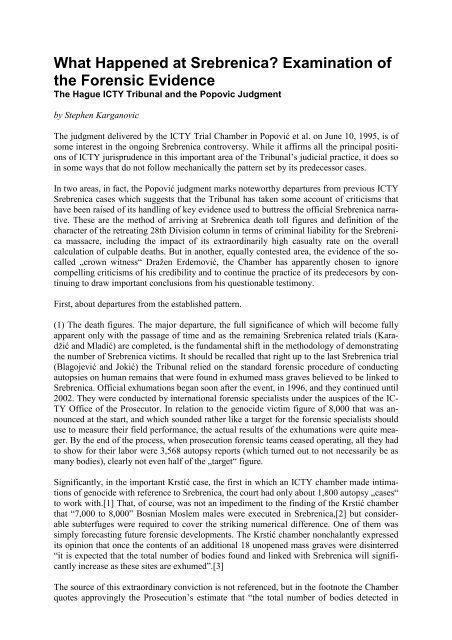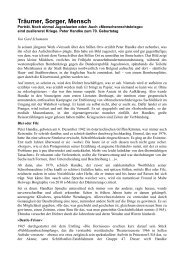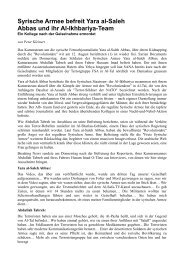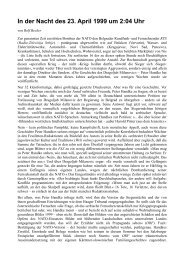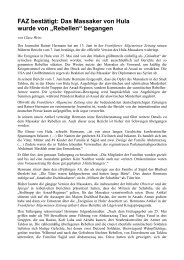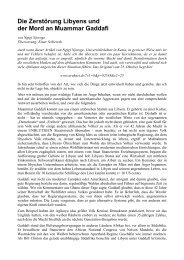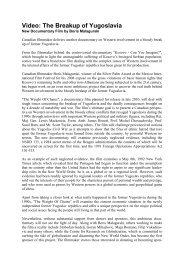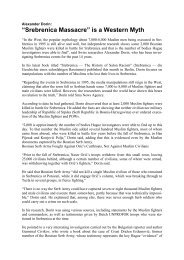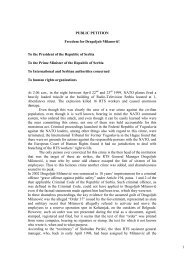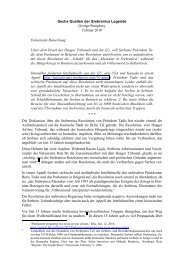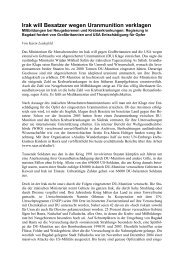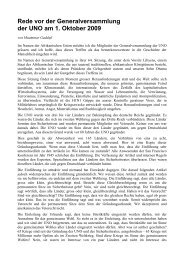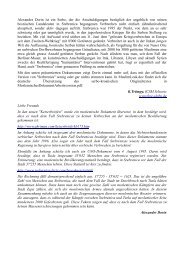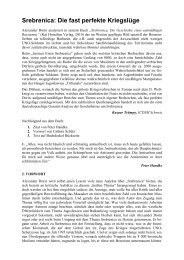What Happened at Srebrenica? Examination of the Forensic Evidence
What Happened at Srebrenica? Examination of the Forensic Evidence
What Happened at Srebrenica? Examination of the Forensic Evidence
Create successful ePaper yourself
Turn your PDF publications into a flip-book with our unique Google optimized e-Paper software.
<strong>Wh<strong>at</strong></strong> <strong>Happened</strong> <strong>at</strong> <strong>Srebrenica</strong>? Examin<strong>at</strong>ion <strong>of</strong><br />
<strong>the</strong> <strong>Forensic</strong> <strong>Evidence</strong><br />
The Hague ICTY Tribunal and <strong>the</strong> Popovic Judgment<br />
by Stephen Karganovic<br />
The judgment delivered by <strong>the</strong> ICTY Trial Chamber in Popović et al. on June 10, 1995, is <strong>of</strong><br />
some interest in <strong>the</strong> ongoing <strong>Srebrenica</strong> controversy. While it affirms all <strong>the</strong> principal positions<br />
<strong>of</strong> ICTY jurisprudence in this important area <strong>of</strong> <strong>the</strong> Tribunal’s judicial practice, it does so<br />
in some ways th<strong>at</strong> do not follow mechanically <strong>the</strong> p<strong>at</strong>tern set by its predecessor cases.<br />
In two areas, in fact, <strong>the</strong> Popović judgment marks noteworthy departures from previous ICTY<br />
<strong>Srebrenica</strong> cases which suggests th<strong>at</strong> <strong>the</strong> Tribunal has taken some account <strong>of</strong> criticisms th<strong>at</strong><br />
have been raised <strong>of</strong> its handling <strong>of</strong> key evidence used to buttress <strong>the</strong> <strong>of</strong>ficial <strong>Srebrenica</strong> narr<strong>at</strong>ive.<br />
These are <strong>the</strong> method <strong>of</strong> arriving <strong>at</strong> <strong>Srebrenica</strong> de<strong>at</strong>h toll figures and definition <strong>of</strong> <strong>the</strong><br />
character <strong>of</strong> <strong>the</strong> retre<strong>at</strong>ing 28th Division column in terms <strong>of</strong> criminal liability for <strong>the</strong> <strong>Srebrenica</strong><br />
massacre, including <strong>the</strong> impact <strong>of</strong> its extraordinarily high casualty r<strong>at</strong>e on <strong>the</strong> overall<br />
calcul<strong>at</strong>ion <strong>of</strong> culpable de<strong>at</strong>hs. But in ano<strong>the</strong>r, equally contested area, <strong>the</strong> evidence <strong>of</strong> <strong>the</strong> socalled<br />
„crown witness“ Dražen Erdemović, <strong>the</strong> Chamber has apparently chosen to ignore<br />
compelling criticisms <strong>of</strong> his credibility and to continue <strong>the</strong> practice <strong>of</strong> its predecesors by continuing<br />
to draw important conclusions from his questionable testimony.<br />
First, about departures from <strong>the</strong> established p<strong>at</strong>tern.<br />
(1) The de<strong>at</strong>h figures. The major departure, <strong>the</strong> full significance <strong>of</strong> which will become fully<br />
apparent only with <strong>the</strong> passage <strong>of</strong> time and as <strong>the</strong> remaining <strong>Srebrenica</strong> rel<strong>at</strong>ed trials (Karadžić<br />
and Mladić) are completed, is <strong>the</strong> fundamental shift in <strong>the</strong> methodology <strong>of</strong> demonstr<strong>at</strong>ing<br />
<strong>the</strong> number <strong>of</strong> <strong>Srebrenica</strong> victims. It should be recalled th<strong>at</strong> right up to <strong>the</strong> last <strong>Srebrenica</strong> trial<br />
(Blagojević and Jokić) <strong>the</strong> Tribunal relied on <strong>the</strong> standard forensic procedure <strong>of</strong> conducting<br />
autopsies on human remains th<strong>at</strong> were found in exhumed mass graves believed to be linked to<br />
<strong>Srebrenica</strong>. Official exhum<strong>at</strong>ions began soon after <strong>the</strong> event, in 1996, and <strong>the</strong>y continued until<br />
2002. They were conducted by intern<strong>at</strong>ional forensic specialists under <strong>the</strong> auspices <strong>of</strong> <strong>the</strong> IC-<br />
TY Office <strong>of</strong> <strong>the</strong> Prosecutor. In rel<strong>at</strong>ion to <strong>the</strong> genocide victim figure <strong>of</strong> 8,000 th<strong>at</strong> was announced<br />
<strong>at</strong> <strong>the</strong> start, and which sounded r<strong>at</strong>her like a target for <strong>the</strong> forensic specialists should<br />
use to measure <strong>the</strong>ir field performance, <strong>the</strong> actual results <strong>of</strong> <strong>the</strong> exhum<strong>at</strong>ions were quite meager.<br />
By <strong>the</strong> end <strong>of</strong> <strong>the</strong> process, when prosecution forensic teams ceased oper<strong>at</strong>ing, all <strong>the</strong>y had<br />
to show for <strong>the</strong>ir labor were 3,568 autopsy reports (which turned out to not necessarily be as<br />
many bodies), clearly not even half <strong>of</strong> <strong>the</strong> „target“ figure.<br />
Significantly, in <strong>the</strong> important Krstić case, <strong>the</strong> first in which an ICTY chamber made intim<strong>at</strong>ions<br />
<strong>of</strong> genocide with reference to <strong>Srebrenica</strong>, <strong>the</strong> court had only about 1,800 autopsy „cases“<br />
to work with.[1] Th<strong>at</strong>, <strong>of</strong> course, was not an impediment to <strong>the</strong> finding <strong>of</strong> <strong>the</strong> Krstić chamber<br />
th<strong>at</strong> “7,000 to 8,000” Bosnian Moslem males were executed in <strong>Srebrenica</strong>,[2] but considerable<br />
subterfuges were required to cover <strong>the</strong> striking numerical difference. One <strong>of</strong> <strong>the</strong>m was<br />
simply forecasting future forensic developments. The Krstić chamber nonchalantly expressed<br />
its opinion th<strong>at</strong> once <strong>the</strong> contents <strong>of</strong> an additional 18 unopened mass graves were disinterred<br />
“it is expected th<strong>at</strong> <strong>the</strong> total number <strong>of</strong> bodies found and linked with <strong>Srebrenica</strong> will significantly<br />
increase as <strong>the</strong>se sites are exhumed”.[3]<br />
The source <strong>of</strong> this extraordinary conviction is not referenced, but in <strong>the</strong> footnote <strong>the</strong> Chamber<br />
quotes approvingly <strong>the</strong> Prosecution’s estim<strong>at</strong>e th<strong>at</strong> “<strong>the</strong> total number <strong>of</strong> bodies detected in
mass graves is 4,805”.[4] Clearly, if <strong>the</strong> Prosecution’s “estim<strong>at</strong>e” were valid<strong>at</strong>ed, th<strong>at</strong> figure<br />
plus <strong>the</strong> approxim<strong>at</strong>ely 1,800 cases available to <strong>the</strong> Chamber <strong>at</strong> th<strong>at</strong> time would make <strong>the</strong><br />
claimed 7,000 to 8,000 de<strong>at</strong>h toll look like a credible analysis.<br />
These specul<strong>at</strong>ions may well have gone unchallenged if Dr. Ljubiša Simić, a member <strong>of</strong> <strong>the</strong><br />
Beara defence team[5], had not bo<strong>the</strong>red in 2008 and 2009 to take a very close look <strong>at</strong> <strong>the</strong><br />
prosecution’s—by <strong>the</strong>n—3,568 autopsy reports, all 30,000 pages <strong>of</strong> <strong>the</strong>m. <strong>Wh<strong>at</strong></strong> he discovered<br />
was startling. One report, or “case”, did not equal one body. In 44,4% <strong>of</strong> <strong>the</strong> “cases” it consisted<br />
<strong>of</strong> only a few bones or fragments from which no forensically significant conclusions<br />
could be drawn. In fact, in 92,4% <strong>of</strong> those <strong>the</strong> prosecution’s own forensic specialists admitted<br />
in <strong>the</strong>ir reports th<strong>at</strong> <strong>the</strong>y could not determine <strong>the</strong> cause and manner <strong>of</strong> de<strong>at</strong>h.<br />
If parameters crucial to criminal liability, such as cause and manner <strong>of</strong> de<strong>at</strong>h, were indeterminable,<br />
how could <strong>the</strong> conclusion be reached th<strong>at</strong> <strong>the</strong> victims were executed as opposed, for<br />
instance, to being killed in <strong>the</strong> course <strong>of</strong> legitim<strong>at</strong>e military action? And how could such uns<strong>at</strong>isfactory<br />
evidence serve fur<strong>the</strong>r to support a grave conclusion, such as genocide?<br />
In contrast to <strong>the</strong> bulk <strong>of</strong> human remains <strong>of</strong>fered by <strong>the</strong> prosecution in support <strong>of</strong> its <strong>Srebrenica</strong><br />
case, and which <strong>the</strong> chamber accepted as ultim<strong>at</strong>ely prob<strong>at</strong>ive <strong>of</strong> genocide, but which seemed<br />
to be devoid <strong>of</strong> any forensic significance, <strong>the</strong>re were only 442 human remains in <strong>the</strong><br />
mass graves with lig<strong>at</strong>ures and/or blindfolds. This was <strong>the</strong> only c<strong>at</strong>egory in a condition th<strong>at</strong><br />
strongly suggested execution.<br />
Dr. Simić meticulously c<strong>at</strong>egorized mass grave remains by degree <strong>of</strong> completeness and p<strong>at</strong>tern<br />
<strong>of</strong> injury. The picture which emerged from his investig<strong>at</strong>ion was most contrary to <strong>the</strong><br />
prosecution’s case, yet it was <strong>the</strong> prosecution’s own evidence th<strong>at</strong> he was dissecting. In <strong>the</strong><br />
end, he canvassed <strong>the</strong> number <strong>of</strong> paired femur bones[6] in <strong>the</strong> autopsy reports in an effort to<br />
determine how many individuals were buried in <strong>Srebrenica</strong> mass graves, having died <strong>of</strong> all<br />
causes. He found a total <strong>of</strong> 1,919 right and 1,923 left femur bones. Thus, with a very high<br />
degree <strong>of</strong> reliability it was established th<strong>at</strong> in total <strong>the</strong>re were under 2,000 individuals in all<br />
<strong>the</strong> <strong>Srebrenica</strong> mass graves exhumed by <strong>the</strong> prosecution. The p<strong>at</strong>terns <strong>of</strong> injury were in some<br />
cases consistent with comb<strong>at</strong> de<strong>at</strong>h, and in o<strong>the</strong>rs with possible execution.<br />
Plainly, on closer examin<strong>at</strong>ion <strong>the</strong> forensic evidence was more unhelpful than helpful to <strong>the</strong><br />
prosecution <strong>the</strong>sis (and, by obvious extension, <strong>the</strong> very <strong>the</strong>sis th<strong>at</strong> <strong>the</strong> Tribunal was hard<br />
pressed to document) th<strong>at</strong> in <strong>Srebrenica</strong> <strong>the</strong>re were about 8,000 execution victims. Ten years<br />
l<strong>at</strong>er, <strong>the</strong>re is no trace <strong>of</strong> <strong>the</strong> 4,805 bodies <strong>the</strong> Krstić court gullibly agreed had been “detected”<br />
in <strong>the</strong> unexhumed <strong>Srebrenica</strong> mass graves. Body counting in <strong>the</strong> classical sense had reached<br />
an embarrassing dead end.<br />
In <strong>the</strong> Popović case, <strong>the</strong> Chamber <strong>the</strong>refore decided to make an end run around <strong>the</strong> issue and<br />
to shift its emphasis to a new technique—DNA:<br />
“Based on <strong>the</strong> evidence, <strong>the</strong> Trial Chamber has found th<strong>at</strong> <strong>at</strong> least 5.336 identified individuals<br />
were killed in <strong>the</strong> executions following <strong>the</strong> fall <strong>of</strong> <strong>Srebrenica</strong>. However, noting th<strong>at</strong> <strong>the</strong> evidence<br />
before it is not all encompassing, <strong>the</strong> Trial Chamber is s<strong>at</strong>isfied th<strong>at</strong> <strong>the</strong> number <strong>of</strong><br />
identified individuals will rise. The Trial Chamber <strong>the</strong>refore considers th<strong>at</strong> <strong>the</strong> number <strong>of</strong> individuals<br />
killed in <strong>the</strong> executions following <strong>the</strong> fall <strong>of</strong> <strong>Srebrenica</strong> could well be as high as<br />
7.826.”[7]<br />
The reference to “identified individuals” indic<strong>at</strong>es <strong>the</strong> source <strong>of</strong> <strong>the</strong> Chamber’s d<strong>at</strong>a: <strong>the</strong> Intern<strong>at</strong>ional<br />
Committee for Missing Persons (ICMP), an NGO with US ties with local
headquarters in Tuzla.[8] ICMP claims to have so far identified 6,414 <strong>Srebrenica</strong> victims.[9]<br />
Superficially, th<strong>at</strong> sounds like genuine progress in <strong>the</strong> critical area <strong>of</strong> victim identific<strong>at</strong>ion.<br />
The problem, however, is th<strong>at</strong> during <strong>the</strong> Popović, where it was <strong>of</strong>ficially unveiled, ICMP<br />
d<strong>at</strong>a was presented in closed session and under severely limiting conditions th<strong>at</strong> gave nei<strong>the</strong>r<br />
time nor adequ<strong>at</strong>e resources to <strong>the</strong> defence to subject this evidence to a thorough scientific<br />
analysis. ICMP strenuously opposes outside inspection and verific<strong>at</strong>ion <strong>of</strong> its results on <strong>the</strong><br />
grounds th<strong>at</strong> it might cause additional pain to <strong>the</strong> survivors and it requires sample donors’<br />
written permission before it will show its raw d<strong>at</strong>a to anyone. Needless to say, in <strong>the</strong> tense and<br />
hostile Balkan context, th<strong>at</strong> is virtually <strong>the</strong> same as denying access.<br />
ICMP’s penchant for secrecy in fact seems to go quite far. After Radovan Karadžić’s open<br />
court complaint th<strong>at</strong> his defence was subjected to discrimin<strong>at</strong>ory tre<strong>at</strong>ment as a result <strong>of</strong><br />
ICMP’s refusal to show <strong>the</strong>ir d<strong>at</strong>a, to everyone’s surprise it was prosecutor Hildegard Uertz-<br />
Retzlaff who revealed th<strong>at</strong> ICMP was no more forthcoming to <strong>the</strong> prosecution:<br />
“The ICMP did also not provide <strong>the</strong> DNA to us. It is not th<strong>at</strong> give it to us and not to<br />
o<strong>the</strong>rs.”[10]<br />
It strikes one as amazing th<strong>at</strong> even <strong>the</strong> proponent <strong>of</strong> this evidence—in this case ICTY Prosecution—should<br />
have been denied <strong>the</strong> privilege <strong>of</strong> properly reviewing it.<br />
While <strong>the</strong> Chamber did hear ICMP Director <strong>of</strong> forensic science Thomas Parsons’ present<strong>at</strong>ion<br />
<strong>of</strong> <strong>the</strong> DNA d<strong>at</strong>a[11] it is not clear whe<strong>the</strong>r it, any more than <strong>the</strong> Prosecution, had actually<br />
seen it, and even if it had a glimpse, <strong>the</strong> record does not show th<strong>at</strong> <strong>the</strong> Chamber bo<strong>the</strong>red to<br />
enlist any expert help to understand it.<br />
To summarise, acceptance and reliance[12] upon ICMP’s critically unexamined evidence<br />
seems first and foremost to be an act <strong>of</strong> faith.<br />
Even if protest<strong>at</strong>ions <strong>of</strong> privacy on behalf <strong>of</strong> <strong>the</strong> survivors who don<strong>at</strong>ed blood samples are to<br />
be accepted <strong>at</strong> face value, now th<strong>at</strong> <strong>the</strong> 5,336 identified victim figure has been enshrined in<br />
<strong>the</strong> <strong>of</strong>ficial Judgment, it would seem simple and convenient to allay doubts by publishing <strong>the</strong><br />
first and last names <strong>of</strong> all <strong>the</strong> 5,336 individuals involved. Th<strong>at</strong> should <strong>of</strong>fend no one’s sensibilities<br />
as thousands <strong>of</strong> names <strong>of</strong> alleged <strong>Srebrenica</strong> victims have already been carved into a<br />
huge slab <strong>of</strong> stone <strong>at</strong> <strong>the</strong> Potočari Memorial Centre to be seen by everyone. The public<strong>at</strong>ion <strong>of</strong><br />
<strong>the</strong>se names <strong>of</strong> victims supposedly identified by DNA would not only be quite sens<strong>at</strong>ional, it<br />
would also make fur<strong>the</strong>r forms <strong>of</strong> verific<strong>at</strong>ion possible. No such list, however, is appended to<br />
<strong>the</strong> Judgment.<br />
But <strong>the</strong> Chamber’s biggest problem in this segment is not its failure to name <strong>the</strong> identified<br />
individuals (identific<strong>at</strong>ion, it should be recalled, means assigning a first and last name r<strong>at</strong>her<br />
than a number to each individual.) Nor is it even its cavalier prediction th<strong>at</strong> “<strong>the</strong> number <strong>of</strong><br />
individuals killed in <strong>the</strong> executions following <strong>the</strong> fall <strong>of</strong> <strong>Srebrenica</strong> could well be as high as<br />
7.826”, a prognosis for which <strong>the</strong>re is no apparent basis and which is distressingly reminiscent<br />
<strong>of</strong> <strong>the</strong> Krstić Chamber’s failed forecast th<strong>at</strong> almost 5,000 unexhumed but “detected” bodies<br />
were on <strong>the</strong> verge <strong>of</strong> being discovered. It is, r<strong>at</strong>her, th<strong>at</strong> <strong>the</strong> Chamber is apparently ignorant <strong>of</strong><br />
how DNA works and <strong>of</strong> wh<strong>at</strong> it can and cannot do.<br />
Th<strong>at</strong> ignorance is reflected in <strong>the</strong> Chamber’s finding th<strong>at</strong> “<strong>at</strong> least 5,336 identified individuals<br />
were killed in <strong>the</strong> executions following <strong>the</strong> fall <strong>of</strong> <strong>Srebrenica</strong>”, which is scientifically impossible.<br />
By m<strong>at</strong>ching samples taken from <strong>the</strong> deceased person to biological m<strong>at</strong>erial don<strong>at</strong>ed by<br />
<strong>the</strong> potential blood rel<strong>at</strong>ive, DNA procedure can establish, with various degrees <strong>of</strong> certainty,
<strong>the</strong> deceased’s probable identity. But in terms th<strong>at</strong> are relevant to criminal liability it can do<br />
nothing more than th<strong>at</strong>. It cannot help determine <strong>the</strong> time and manner <strong>of</strong> de<strong>at</strong>h. The deceased,<br />
whose first and last name as a result <strong>of</strong> successful m<strong>at</strong>ching may have been established, could<br />
have been killed in comb<strong>at</strong>, in an accident, or could have died <strong>of</strong> n<strong>at</strong>ural causes. The casual<br />
suggestion made by <strong>the</strong> Chamber, th<strong>at</strong> <strong>the</strong> 5,336 identified individuals “were killed in <strong>the</strong><br />
executions following <strong>the</strong> fall <strong>of</strong> <strong>Srebrenica</strong>” is scientifically unwarranted and, as any biology<br />
student could inform <strong>the</strong> Chamber, it is absurd on its face. No one can make such a determin<strong>at</strong>ion<br />
based on DNA d<strong>at</strong>a without exposing <strong>the</strong>mselves to enormous ridicule.<br />
But this is a determin<strong>at</strong>ion which <strong>the</strong> Chamber simply had to make, because without <strong>the</strong> time<br />
and manner <strong>of</strong> de<strong>at</strong>h claim to go with it, <strong>the</strong> pompously announced DNA identific<strong>at</strong>ion evidence<br />
is quite useless for conviction purposes.<br />
It can be argued th<strong>at</strong> <strong>the</strong> Chamber acted most unwisely by embracing <strong>the</strong> DNA approach without<br />
<strong>at</strong> least consulting a biology student about its usefulness before doing so. Once this<br />
segment <strong>of</strong> <strong>the</strong> Judgment is subjected to thorough critical analysis, ICTY will discover th<strong>at</strong> it<br />
will get even less in terms <strong>of</strong> genuine conviction evidence than was <strong>the</strong> case with <strong>the</strong> apparently<br />
jettisoned standard forensic approach. The standard approach <strong>at</strong> least had yielded 947<br />
potential execution victims (442 with blindfolds and lig<strong>at</strong>ures, plus 505 with bullet injuries).<br />
The methodology shift to DNA is incapable <strong>of</strong> demonstr<strong>at</strong>ing a single de<strong>at</strong>h in terms <strong>of</strong> legally<br />
relevant characteristics. It seeks to impress with <strong>the</strong> aura <strong>of</strong> high tech, but like any bluff<br />
it can last only as long as it remains unchallenged or, in this case, unexamined.<br />
(2) The 28th Division column. The st<strong>at</strong>us <strong>of</strong> <strong>the</strong> 12,000 to 15,000 strong mixed military/civilian<br />
mostly male column which left <strong>Srebrenica</strong> enclave on foot l<strong>at</strong>e on July 11, 1995,<br />
headed for Moslem-controlled territory in Tuzla is a key factor in <strong>the</strong> controversy <strong>of</strong> <strong>Srebrenica</strong>.<br />
Prosecution military expert Richard Butler conceded <strong>the</strong> mixed character <strong>of</strong> <strong>the</strong> column,<br />
which under intern<strong>at</strong>ional law made it a legitim<strong>at</strong>e military target.[13] Testifying in <strong>the</strong> Popović<br />
case, Butler reiter<strong>at</strong>ed this position.[14]<br />
The legal character <strong>of</strong> <strong>the</strong> column and <strong>the</strong> extent <strong>of</strong> its casualties are <strong>of</strong> <strong>the</strong> utmost importance<br />
because in an effort to reach <strong>the</strong> magic figure <strong>of</strong> 8,000 column losses are commonly confl<strong>at</strong>ed<br />
with execution victims. Th<strong>at</strong> approach is quite improper because <strong>the</strong> column’s casualties are<br />
legally legitim<strong>at</strong>e and give rise to no criminal liability wh<strong>at</strong>soever. Referring to <strong>the</strong> column,<br />
Jean-Rene Ruez, chief ICTY prosecution investig<strong>at</strong>or, st<strong>at</strong>ed th<strong>at</strong>,<br />
“A significant number [<strong>of</strong> Moslems] were killed in comb<strong>at</strong>. The Zvornik Brigade <strong>of</strong> <strong>the</strong> VRS<br />
Drina Corps had organized ambushes and th<strong>at</strong> is when it had <strong>the</strong> most casualties during <strong>the</strong><br />
entire war. Many were killed while trying to make it through minefields. An unknown number<br />
probably committed suicide in fear <strong>of</strong> being tortured before being put to de<strong>at</strong>h. It cannot be<br />
excluded th<strong>at</strong> some had shot those who may have wanted to surrender.”[15]<br />
In fact, based on st<strong>at</strong>ements given by surviving column members who reached Tuzla,[16] and<br />
which are also in <strong>the</strong> ICTY electronic d<strong>at</strong>a base,[17] many <strong>of</strong> <strong>the</strong> engagement sites have been<br />
identified and eyewitness estim<strong>at</strong>es <strong>of</strong> casualties are available.[18]<br />
These casualties were estim<strong>at</strong>ed by prosecution military expert Richard Butler, when testifying<br />
in <strong>the</strong> Popović trial, to have been 1,000 to 2,000 for <strong>the</strong> period <strong>of</strong> July 12 to 18, 1995.[19]<br />
In a July 17, 1995, UN internal report it is estim<strong>at</strong>ed regarding <strong>the</strong> column th<strong>at</strong> “up to three<br />
thousand were killed on <strong>the</strong> way, mostly by mines and BSA [Bosnian Serb Army] engagements.”[20]<br />
In <strong>the</strong> “UNMO HQ Daily Sitrep” for July 18, 1995, speaking <strong>of</strong> <strong>the</strong> column it is<br />
estim<strong>at</strong>ed th<strong>at</strong> 3,000 were “believed to have been killed by minefields, snipers, and ambush
conflict with BSA”.[21] So all <strong>the</strong>se estim<strong>at</strong>es and reports, while lacking absolute precision,<br />
never<strong>the</strong>less converge on <strong>the</strong> conclusion th<strong>at</strong> <strong>the</strong> retre<strong>at</strong>ing 28th Division column did suffer<br />
significant casualties along <strong>the</strong> way.<br />
The technical problem which <strong>the</strong> column presents is two-fold. First, it demands separ<strong>at</strong>e analysis<br />
and c<strong>at</strong>egoriz<strong>at</strong>ion for <strong>Srebrenica</strong>-rel<strong>at</strong>ed events which suggest legitim<strong>at</strong>e comb<strong>at</strong> and<br />
cannot be fitted into <strong>the</strong> Procrustean bed <strong>of</strong> genocide, as <strong>the</strong> ne<strong>at</strong> and simple <strong>Srebrenica</strong> narr<strong>at</strong>ive<br />
requires. So, in <strong>the</strong> first place, politically and psychologically it gre<strong>at</strong>ly alters <strong>the</strong> simplistic<br />
picture th<strong>at</strong> has been relentlessly emitted over <strong>the</strong> years. Secondly, it apparently involves<br />
casualties in <strong>the</strong> thousands th<strong>at</strong> cannot easily be brought within <strong>the</strong> ambit <strong>of</strong> war crimes.<br />
Given <strong>the</strong> severe dearth <strong>of</strong> bona fide execution victims, <strong>the</strong> presence <strong>of</strong> thousands <strong>of</strong> legitim<strong>at</strong>e<br />
casualties is <strong>at</strong> worst an embarrassment and, <strong>at</strong> best, an opportunity. The opportunity is<br />
to simply blend <strong>the</strong>m in with execution victims, thus elimin<strong>at</strong>ing <strong>the</strong> problem and <strong>at</strong> <strong>the</strong> same<br />
time helpfully raising <strong>the</strong> victims’ total, even if it still remains short <strong>of</strong> <strong>the</strong> target figure <strong>of</strong><br />
8,000.<br />
It seems th<strong>at</strong> <strong>the</strong> Popović Chamber has opted to seize <strong>the</strong> opportunity. It admits th<strong>at</strong> <strong>the</strong> column<br />
was shelled with artillery and hand grenades, presumably causing widespread casualties,<br />
and th<strong>at</strong> some members <strong>of</strong> <strong>the</strong> column committed suicide. [22] But <strong>the</strong>n it goes on to argue<br />
th<strong>at</strong> <strong>the</strong> column was in its composition (and presumably its legal character as well, though th<strong>at</strong><br />
is never st<strong>at</strong>ed explicitly) indistinguishable from <strong>the</strong> women, children, and elderly <strong>Srebrenica</strong><br />
enclave inhabitants who had g<strong>at</strong>hered <strong>at</strong> <strong>the</strong> UN base in Potočari. Having practically erased<br />
<strong>the</strong> legal distinction, <strong>the</strong> Chamber <strong>the</strong>n draws <strong>the</strong> n<strong>at</strong>ural conclusion: <strong>the</strong> column (and by implic<strong>at</strong>ion<br />
its casualties) was part <strong>of</strong> <strong>the</strong> “widespread and system<strong>at</strong>ic <strong>at</strong>tack against <strong>the</strong> civilian<br />
popul<strong>at</strong>ion.”[23]<br />
There is, <strong>of</strong> course, no subtle or refined legal analysis here, but <strong>the</strong> conclusion does serve <strong>the</strong><br />
Chamber’s practical purpose. By erasing <strong>the</strong> legal distinction between <strong>the</strong> two groups, it also<br />
did away with <strong>the</strong> necessity for bo<strong>the</strong>rsome account-keeping in terms <strong>of</strong> which victim was<br />
unlawfully executed and which was a legitim<strong>at</strong>e casualty. Given <strong>the</strong> severe shortage <strong>of</strong> execution<br />
victims, <strong>the</strong> Chamber’s practical solution is understandable. But it is certainly not to its<br />
credit pr<strong>of</strong>essionally any more than <strong>the</strong> misrepresent<strong>at</strong>ion <strong>of</strong> wh<strong>at</strong> can be expected from DNA<br />
results.<br />
(3) The Erdemović evidence. While <strong>the</strong> introduction <strong>of</strong> DNA evidence and its elev<strong>at</strong>ion to <strong>the</strong><br />
st<strong>at</strong>us <strong>of</strong> primary analytical tool for estim<strong>at</strong>ing Moslem losses, and <strong>the</strong> simultaneous downgrading<br />
<strong>of</strong> <strong>the</strong> 28th Division column to virtually an extension <strong>of</strong> <strong>the</strong> civilian popul<strong>at</strong>ion, appear<br />
to be departures from <strong>the</strong> way in which <strong>the</strong>se topics were being approached in previous<br />
<strong>Srebrenica</strong> trials, <strong>the</strong> Popović Chamber’s wholehearted embrace <strong>of</strong> Dražen Erdemović’s evidence<br />
can safely be filed in <strong>the</strong> “more <strong>of</strong> <strong>the</strong> same” c<strong>at</strong>egory. In this particular case, <strong>the</strong> Tribunal<br />
was oblivious to <strong>the</strong> intense and cogent questioning <strong>of</strong> Erdemović’s credibility coming<br />
from various sources. The most prominent <strong>of</strong> <strong>the</strong>m was Germinal Čivikov’s devast<strong>at</strong>ing critique,<br />
“Crown Witness,”[24] published initially in German, <strong>the</strong>n in Serbian in <strong>the</strong> Fall <strong>of</strong><br />
2009, and now waiting to appear in English transl<strong>at</strong>ion.<br />
In fact, <strong>the</strong> Chamber’s use <strong>of</strong> Erdemović’s evidence startles with its boldness. The following<br />
example, bearing on <strong>the</strong> identific<strong>at</strong>ion <strong>of</strong> defendant Vujadin Popović <strong>at</strong> a key crime scene,<br />
will do.<br />
Here is how <strong>the</strong> Chamber approaches <strong>the</strong> issue <strong>of</strong> identific<strong>at</strong>ion <strong>of</strong> one <strong>of</strong> <strong>the</strong> principal accused:
”There is no evidence before <strong>the</strong> Trial Chamber <strong>of</strong> any o<strong>the</strong>r Lieutenant Colonel in Pilica <strong>at</strong><br />
this time. In light <strong>of</strong> this, <strong>the</strong> Trial Chamber is s<strong>at</strong>isfied th<strong>at</strong> <strong>the</strong>re is no o<strong>the</strong>r reasonable conclusion<br />
available on <strong>the</strong> evidence but th<strong>at</strong> <strong>the</strong> Lieutenant Colonel whom Erdemović saw <strong>at</strong><br />
Branjevo Military Farm and in Pilica town on 16 July was Popović.”[25]<br />
The way in which <strong>the</strong> Chamber handled <strong>the</strong> identific<strong>at</strong>ion <strong>of</strong> <strong>the</strong> mysterious “lieutenantcolonel”<br />
is curious indeed. His presence in Pilica is assumed, not for some objective reason,<br />
but because it was Erdemović who said so. The picture drawn by Erdemović by hook or by<br />
crook must be rounded <strong>of</strong>f with an identified lieutenant-colonel on <strong>the</strong> crime scene, and it<br />
seems to m<strong>at</strong>ter little who th<strong>at</strong> individual might turn out to be. By happenstance, in <strong>the</strong> courtroom,<br />
in <strong>the</strong> dock, <strong>the</strong>re was indeed a real life lieutenant-colonel, <strong>the</strong> defendant Vujadin Popović.<br />
The possibility th<strong>at</strong> Erdemović may have invented <strong>the</strong> lieutenant-colonel as he did a<br />
number <strong>of</strong> o<strong>the</strong>r things in his evidence, does not disconcert <strong>the</strong> Chamber in <strong>the</strong> slightest. It<br />
goes on to render its conclusion:<br />
“The Trial Chamber has carefully considered <strong>the</strong> fact th<strong>at</strong> Erdemović was unable to identify<br />
Popović in a photo line up … However, <strong>the</strong> Trial Chamber considers th<strong>at</strong> given <strong>the</strong> traum<strong>at</strong>ic<br />
circumstances in which Erdemović met Popović and <strong>the</strong> significant passage <strong>of</strong> time since<br />
<strong>the</strong>n, Erdemović’s failure to identify Popović in a photo line up does not raise a reasonable<br />
doubt as to <strong>the</strong> Trial Chamber’s conclusion th<strong>at</strong> <strong>the</strong> man whom Erdemović saw <strong>at</strong> Pilica on 16<br />
July was, in fact, Popović”.[26]<br />
The impression th<strong>at</strong> <strong>the</strong> Popović trial chamber is incapable <strong>of</strong> functioning without reliance on<br />
<strong>the</strong> discredited “crown witness”, Dražen Erdemović, is overwhelming. The Hague Tribunal’s<br />
toxic dependence on <strong>the</strong> evidence <strong>of</strong> <strong>the</strong> notoriously false witness Erdemović is reflected in<br />
<strong>the</strong> way <strong>the</strong> Chamber approached <strong>the</strong> issue <strong>of</strong> placing <strong>the</strong> accused VRS Lt. Colonel Vujadin<br />
Popović on <strong>the</strong> crime scene in Branjevo and Pilica. There was no o<strong>the</strong>r evidence but Erdemović’s<br />
th<strong>at</strong> could possibly put him <strong>the</strong>re. But <strong>the</strong> Chamber simply had to engineer a way to<br />
make sure Popović was <strong>the</strong>re, and so it did. O<strong>the</strong>rwise, it would lack a plausible r<strong>at</strong>ionale for<br />
connecting him to <strong>the</strong> crime and sentencing him to life imprisonment. If it had to resort to <strong>the</strong><br />
feeble excuse th<strong>at</strong> <strong>the</strong> photo line-up crashed because Erdemović was too traum<strong>at</strong>ised to give<br />
<strong>the</strong> proper response, so be it.<br />
The Popović judgment fails as a serious act <strong>of</strong> juurisprudence on many levels. It reflects institutional<br />
arrogance and corruption in <strong>the</strong> highest degree. Since <strong>Srebrenica</strong> is <strong>the</strong> core factual<br />
and legal issue th<strong>at</strong> <strong>the</strong> Tribunal has assigned to itself to deal with and „resolve“, not just in<br />
judicial but indeed in moral and historical terms, <strong>the</strong>se and o<strong>the</strong>r fe<strong>at</strong>ures <strong>of</strong> <strong>the</strong> Popović<br />
judgment portend <strong>the</strong> techniques th<strong>at</strong> <strong>the</strong> Tribunal will most likely use as it prepares to strike<br />
its farewell blows in <strong>the</strong> Karadžić and, potentially, Mladić trials.<br />
If this is a preview, it fails to impress with <strong>the</strong> sophistic<strong>at</strong>ion <strong>of</strong> its approach. But <strong>the</strong> Tribunal<br />
probably sees no reason to even try to be sophistic<strong>at</strong>ed in <strong>the</strong> fabric<strong>at</strong>ion <strong>of</strong> its evidence or in<br />
<strong>the</strong> formul<strong>at</strong>ion <strong>of</strong> its bogus legal doctrines. It apparently feels invulnerable under <strong>the</strong> protection<br />
<strong>of</strong> its mighty “hyperpower” sponsors. The issue its willing tools and enablers are not<br />
addressing is precisely for how long th<strong>at</strong> protective shield can last. It is, in fact, crumbling<br />
before our eyes and <strong>the</strong>y may well be called to account pr<strong>of</strong>essionally long before <strong>the</strong>y are<br />
able to settle comfortably to enjoy <strong>the</strong> ill-deserved pensions, perquisites, and sundry munificent<br />
rewards th<strong>at</strong> have undoubtedly been set aside for <strong>the</strong>m by <strong>the</strong>ir masters.<br />
Stephen Karganovic is President <strong>of</strong> <strong>the</strong> Dutch-based NGO “<strong>Srebrenica</strong> Historical Project.”
Notes<br />
[1] The number stabilised <strong>at</strong> 3,568 by 2002 when fur<strong>the</strong>r ICTY exhum<strong>at</strong>ions were discontinued.<br />
[2] Prosecutor v. Krstić, trial judgment, par. 84.<br />
[3] Prosecutor v. Krstić, trial judgment, par. 80..<br />
[4] Prosecutor v. Krstić, trial judgment, par. 80, footnote 166.<br />
[5] Ljubiša Beara: one <strong>of</strong> <strong>the</strong> Popović et al. co-defendants.<br />
[6] The femur is one <strong>of</strong> <strong>the</strong> sturdiest skeletal components and <strong>the</strong>refore least likely to be degraded as a result <strong>of</strong><br />
exposure to unfavorable external conditions.<br />
[7] Prosecutor v. Popović et al., Judgment summary,<br />
http://www.icty.org/x/cases/popovic/tjug/en/100610summary.pdf<br />
[8] Popović Trial Judgment, par. 638 and passim.<br />
[9] ICMP, “ICMP makes 13,000 DNA-led identific<strong>at</strong>ions <strong>of</strong> missing persons from Bosnia-Herzegovina”, 26<br />
March 2010, http://www.ic-mp.org/press-releases/icmp-makes-13000-dna-led-identific<strong>at</strong>ions-<strong>of</strong>-missingpersons-from-bosnia-herzegovinaicmp-ostvario-13000-dnk-identifikacija-osoba-nestalih-u-bosni-ihercegovini/.<br />
[10] Prosecutor v. Karadžić, St<strong>at</strong>us conference, T. July 23, 2009, p. 364, lines 21-23.<br />
[11] Popović Trial Judgment, par. 639.<br />
[12] Popović Trial Judgment, par. 624.<br />
[13] Richard Butler, Expert report, par. 3.21, November 1, 2002, EDS (Tribunal d<strong>at</strong>a base) number 03072366.<br />
[14] Prosecutor v. Popović, T. P.20244, lines 19-25, p. 20245, line 1.<br />
[15] Monitor newspaper [Montenegro], April 19, 2001. EDS number 06038344.<br />
[16] For a sustained analysis and discussion <strong>of</strong> witness st<strong>at</strong>ements on column casualties, see: Stephen Karganovic<br />
and Ljubisa Simic, “<strong>Srebrenica</strong>: Deconstruction <strong>of</strong> a Virtual Genocide” (Belgrade 2010), available on<br />
<strong>the</strong> internet <strong>at</strong>:<br />
http://www.srebrenica-project.com/index.php?<br />
option=com_content&view=article&id=90:any-lieutenant-colonel-will-do&c<strong>at</strong>id=12:2009-01-25-02-01-02<br />
[17] See Stephen Karganovic: “Analysis <strong>of</strong> Moslem Column Losses Due to Minefields and Comb<strong>at</strong> Activity,”<br />
Proceedings <strong>of</strong> <strong>the</strong> Intern<strong>at</strong>ional Symposium on ICTY and <strong>Srebrenica</strong>, p. 376-391 {Belgrade-Moscow<br />
2010).<br />
Available on <strong>the</strong> internet <strong>at</strong>:<br />
http://www.srebrenica-project.com/index.php?<br />
option=com_content&view=c<strong>at</strong>egory&layout=blog&id=21&Itemid=19<br />
[18] In <strong>the</strong> Krstić judgment, it is conceded th<strong>at</strong> <strong>the</strong> column was subjected to “heavy shooting and shelling,” par.<br />
65.The Chamber did not dispute <strong>the</strong> conclusion, stipul<strong>at</strong>ed by prosecution and defence experts, th<strong>at</strong> “<strong>the</strong><br />
column qualified as a legitim<strong>at</strong>e military target”, par. 163.<br />
[19] Prosecutor v. Popović, T. P.20251, lines 6-8, and 12-14.<br />
[20] ICTY electronic d<strong>at</strong>a base number R043-3424.<br />
[21] ICTY electronic d<strong>at</strong>a base number R003-8723.<br />
[22] Popović Trial Judgment, par. 381.<br />
[23] Popović Trial Judgment, par. 782.<br />
[24] Germinal Civikov: Crown Witness [Belgrade 2009].<br />
[25] Popović Trial Judgment, par. 1134.<br />
[26] Popović et al., trial judgment, par. 1135.<br />
Global Research, June 20, 2010


